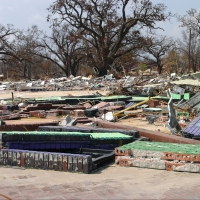New FINDER Technology Can Detect a Heartbeat Buried in Rubble

There are potential nightmare scenarios for first responders. A trench collapse accident occurs at a construction site. A building undergoing demolition collapses. A natural disaster—tornado, earthquake, avalanche, fire—occurs. All of these scenarios mean someone could be buried alive, under a pile of debris, and rescue workers are on the clock to locate survivors.
New radar-based technology developed by NASA’s Jet Propulsion Laboratory and the Department of Homeland Security's Science and Technology Directorate has the potential to assist rescue workers to pinpoint the human heartbeat of victims buried in rubble and potentially save lives, according to an announcement from NASA.
The technology, dubbed FINDER (Finding Individuals for Disaster and Emergency Response), can detect and distinguish a human heartbeat buried beneath thirty feet of crushed materials, hidden behind twenty feet of solid concrete, and from a distance of one hundred feet in open spaces.
According to experts at NASA's Jet Propulsion Laboratory in Pasadena, California:
JPL uses advanced data processing systems to pick out faint signals. The microwave radar technology is sensitive enough to distinguish the unique signature of a human's breathing pattern and heartbeat from that of other living creatures, such as rats. The advantage of this technology is to allow first responders to quickly ascertain if a living human is present in the debris. The technology is sensitive enough that victims, whether conscious or not, can easily be detected, which helps responders decide the most efficient course of action.
The device core is a lightweight sensing module that uses a USB interface to integrate an antenna, radar electronics, and digital processing, with a battery life designed to last up to fourteen hours. The FINDER technology has already undergone successful field testing.
During June 2013, the Jet Propulsion Laboratory and the Department of Homeland Security conducted more than sixty-five test searches with two elite Urban Search and Rescue teams: Virginia Task Force 1 at the Fairfax County Fire Department training center and Virginia Task Force 2 in Virginia Beach, Virginia. A task force member was detected while buried in thirty feet of mixed concrete, rebar, and gravel rubble from a distance of more than thirty feet.
Then in September 2013, NBC News reported that firefighters of Virginia Task Force 1 conducted additional testing. "To my knowledge no one has delivered an actual product that is usable by first responders that detects heartbeat," Jim Lux, a task manager on the FINDER project, developed at NASA's Jet Propulsion Labs, told NBC News. "But if someone is unconscious and unresponsive, [a] heartbeat's the only thing you've got."
The goal is that the technology can complement current search and rescue tools such as canines, listening devices, and video cameras. “It is anticipated that a commercialized technology could be ready to be used in search and rescue operations as early as spring 2014,” said John Price, Department of Homeland Security’s Science and Technology Directorate program manager.

